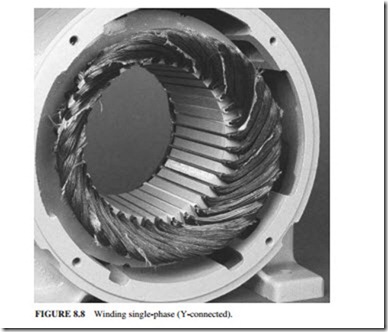TYPICAL CAUSES OF WINDING FAILURES IN THREE-PHASE STATORS
The life of a three-phase stator winding can be shortened dramatically when the motor is exposed to unfavorable operating conditions—electrical, mechanical or environmental. The winding failures illustrated below are typical of what can happen in such circum- stances. They are shown here to help identify the causes of failure, so that, where possible, preventive measures may be taken.
*Reprinted with permission from Failures in Three-Phase Stator Windings, Electrical Apparatus Association, Inc., St. Louis, Mo.
A single-phase winding failure is the result of an open in one phase of the power sup- ply to the motor (Figs. 8.8 and 8.9). The open is usually caused by a blown fuse, an open contactor, a broken power line, or bad connections.
Figures 8.10 to 8.15 illustrate insulation failures that typically are caused by contaminants, abrasion, vibration, or voltage surge.
Thermal deterioration of insulation in one phase of the stator winding can result from unequal voltage between phases (Fig. 8.16). Unequal voltages usually are caused by unbalanced loads on the power source, a poor connection at the motor terminal, or a high-resistance contact (weak spring). Note: A 1 percent voltage unbalance may result in a 6 to 10 percent current unbalance.
Thermal deterioration of the insulation in all phases of the stator winding typically is caused by load demands exceeding the rating of the motor. (Fig. 8.17). Note: Undervoltage and overvoltage (exceeding NEMA standards) will result in the same type of insulation deterioration.
Severe thermal deterioration of the insulation in all phases of the motor normally is caused by very high currents in the stator winding due to a locked-rotor condition (Fig. 8.18). It may also occur as a result of excessive starts or reversals.
Insulation failures like the one shown in Fig. 8.19 usually are caused by voltage surges. Voltage surges are often the result of switching power circuits, lightning strikes, capac- itor discharges, and solid-state power devices.
